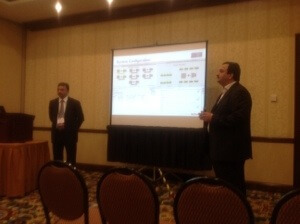 Emerson’s Asad Malik, Sanjeev Vyas, and Zyad Al Irhayim presented, Petroleum Company improves Pump Health Monitoring and Secures Production Goals with Emerson Wireless Vibration Monitoring Technology. Their abstract:
Emerson’s Asad Malik, Sanjeev Vyas, and Zyad Al Irhayim presented, Petroleum Company improves Pump Health Monitoring and Secures Production Goals with Emerson Wireless Vibration Monitoring Technology. Their abstract:
Petroleum Company in ME monitors critical pumps across their oil field using an offline data collection technology. It takes one whole month for operators to collect all vibration data from all the pumps. Condition monitoring & reliability team have to wait for the output of every collection cycle to analyze and address pump health issues. The success of Emerson wireless monitoring technology Pilot project convinced Company to launch a full scale project that would cover 106 critical pumps across Company’s South field and bring more benefits in terms of Operation reliability.
Zyad opened noting that a petroleum company he worked with was monitoring critical pumps with offline technologies. The pumps delivered crude oil to the main pumping station. The application included 106 pumps and vibration was manually collected on each pump once per month. Downtime costed the company more than $100,000 per hour.
For a pilot project they installed a CSI 9240 wireless vibration transmitters. During the pilot, one of the vibration sensors picked up a high vibration, but it was ignored for a month, because the operating personnel were unfamiliar with the readings. An engineer discovered the high vibration and asked the maintenance team to check it out.
The pump was cavitating caused by a faulty level transmitter. Capturing this one instance and avoiding a shutdown was enough to convince this oil producer’s engineering staff to seek to put online vibration monitoring on the pumps, add AMS Machinery Health Monitor software, and provide training to the staff.
Zyad explained that the project was scoped into 3 clusters with the first phase scheduled to last 18 weeks. There were challenges in that the production sites were scattered and the network was complex and required access through firewalls. Viewing the vibration information needed to be done locally at the production sites and in a central remote location. The architecture was designed by the local Emerson team with support from the Asset Optimization organization in Knoxville, Tennessee USA.
Pump trips have been reduced 50% and vibration data comes to the operators every 30 minutes instead of 30 days. Overall plant uptime and reliability has been improved. The path from pilot to full scale and an additional 20 pumps beyond the original 106 pumps.




